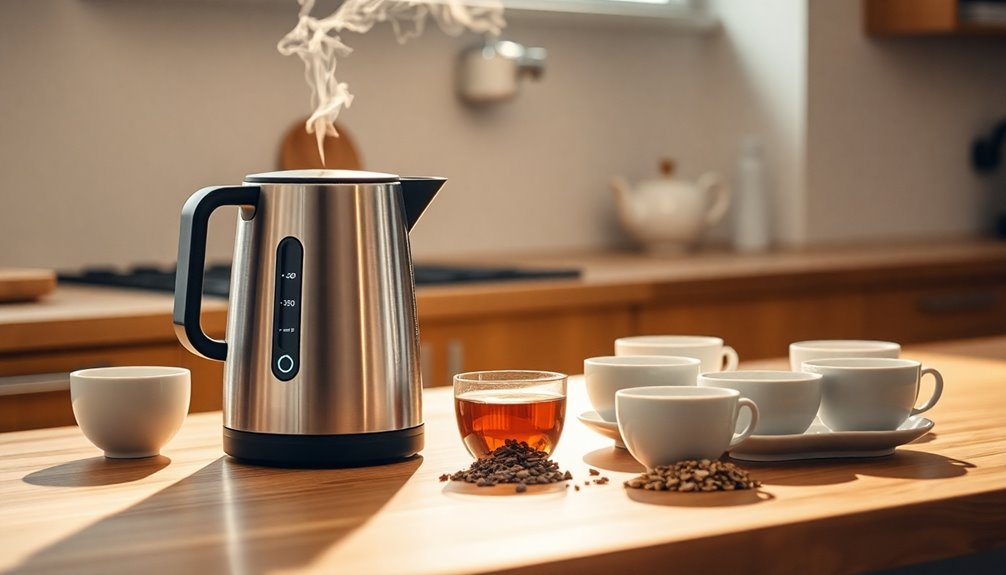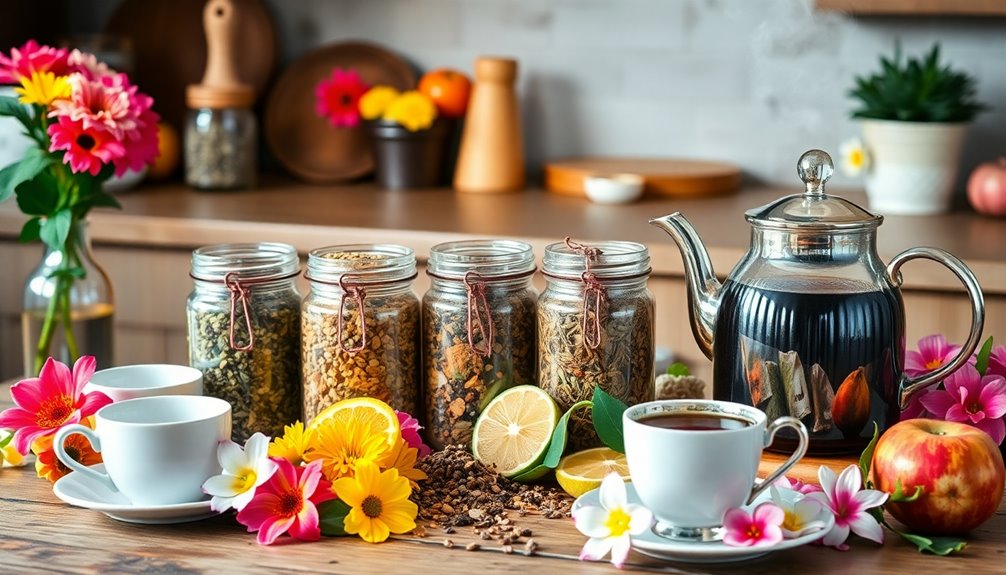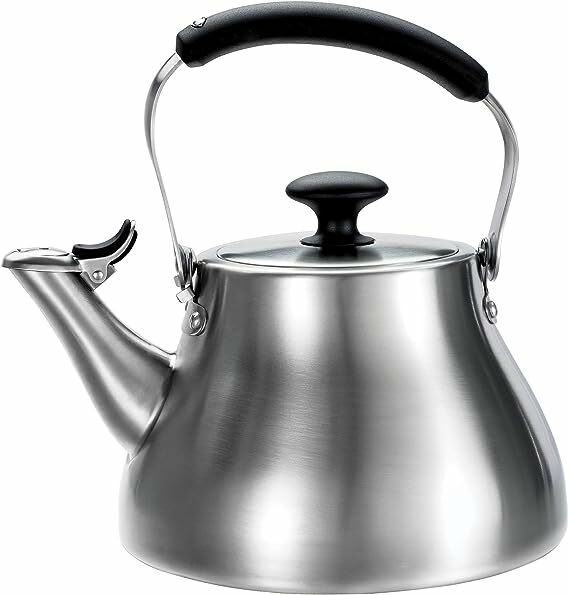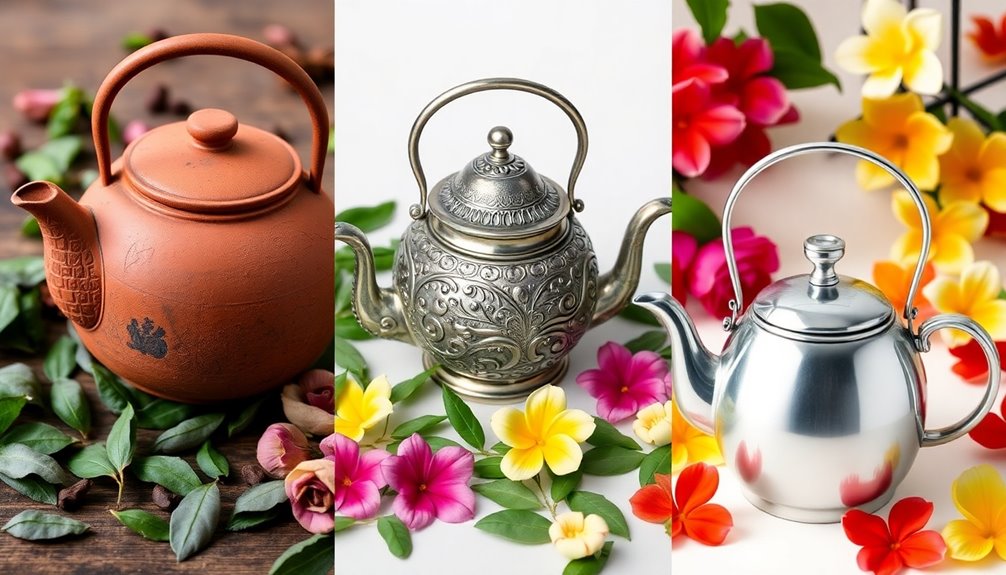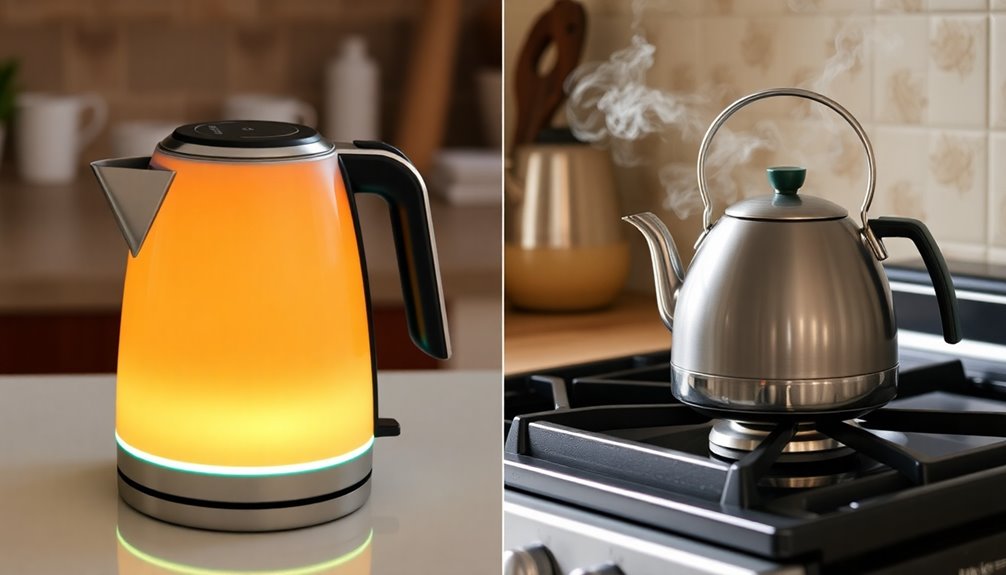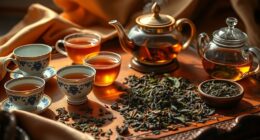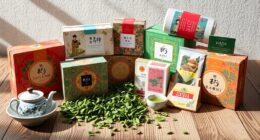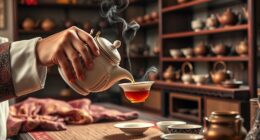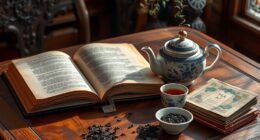Temperature control kettles are a game-changer for your tea experience. They let you set precise temperatures for different types of tea, which helps enhance flavors and prevent bitterness. For example, green tea tastes best at 65°C to 80°C, while black tea shines at 93°C to 100°C. Some kettles even have smart features, allowing you to adjust settings from your phone and maintain the perfect temperature for multiple brews. This control ensures you'll enjoy your tea just the way you like it, making every cup a delight. Stick around to uncover more tips on brewing the perfect cup!
Key Takeaways
- Temperature control kettles ensure precise brewing temperatures, enhancing the flavor and aroma of various tea types.
- Swift heating capabilities save time, making it easier to enjoy specialty teas quickly.
- Adjustable settings allow for tailored brewing methods, catering to individual taste preferences.
- Smart kettles provide app control and notifications for real-time temperature monitoring and automation.
- Consistent temperature control prevents bitterness in delicate teas and ensures quality across multiple brews.
Introduction
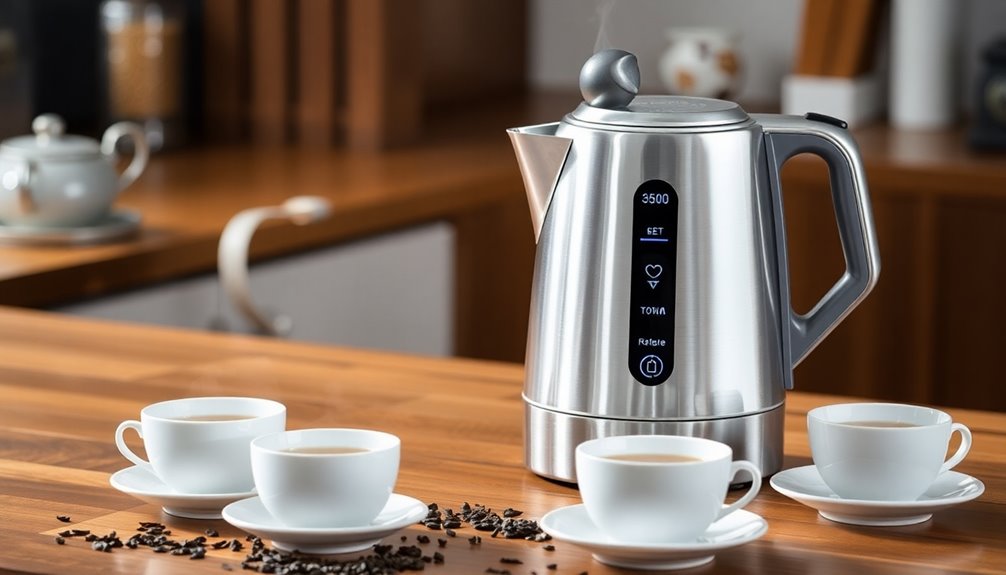
When you brew tea, the right temperature can make all the difference in flavor and aroma. For tea enthusiasts, using modern electric kettles with precise temperatures is a game-changer.
These kettles allow you to set adjustable temperature settings, ensuring that each type of tea brews at its optimal temperature. For example, green tea tastes best at around 65°C to 80°C, while black tea needs a hotter range of 93°C to 100°C.
The user-friendly features of these kettles, like preset temperatures and hold functions, make it easy for anyone to enjoy a perfect cup of tea every time. You won't have to worry about bitterness or under-extraction anymore!
Plus, thanks to swift heating capabilities, you can get your water ready much faster than with a stovetop kettle. This is perfect for busy lifestyles where every minute counts.
Investing in a temperature control kettle aligns with the growing trend of specialty tea consumption, letting you explore different flavors and aromas with confidence. Additionally, brewing flower teas at their optimal steeping time can enhance their unique health benefits and flavors.
Temperature Precision in Brewing
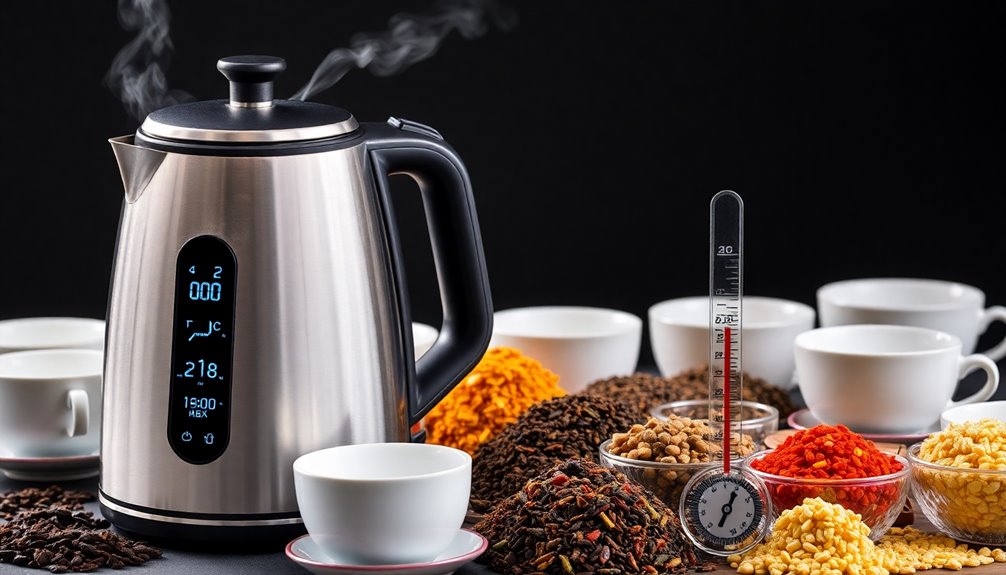
Temperature precision plays a crucial role in brewing the perfect cup of tea. With modern kettles equipped with temperature control features, you can easily select precise water temperatures for different types of tea.
For instance, green tea tastes best at a specific temperature between 65°C and 80°C, while black tea thrives at higher temperatures, between 93°C and 100°C.
These kettles often offer adjustable temperature settings in small increments, sometimes as little as 5°F. This flexibility means you can tailor your brewing methods to suit your personal taste and the variety of tea you're enjoying.
The temperature hold feature is another fantastic addition, allowing you to maintain that ideal temperature for multiple cups, ensuring consistent temperature control every time.
Optimal Brewing Temperatures Matter
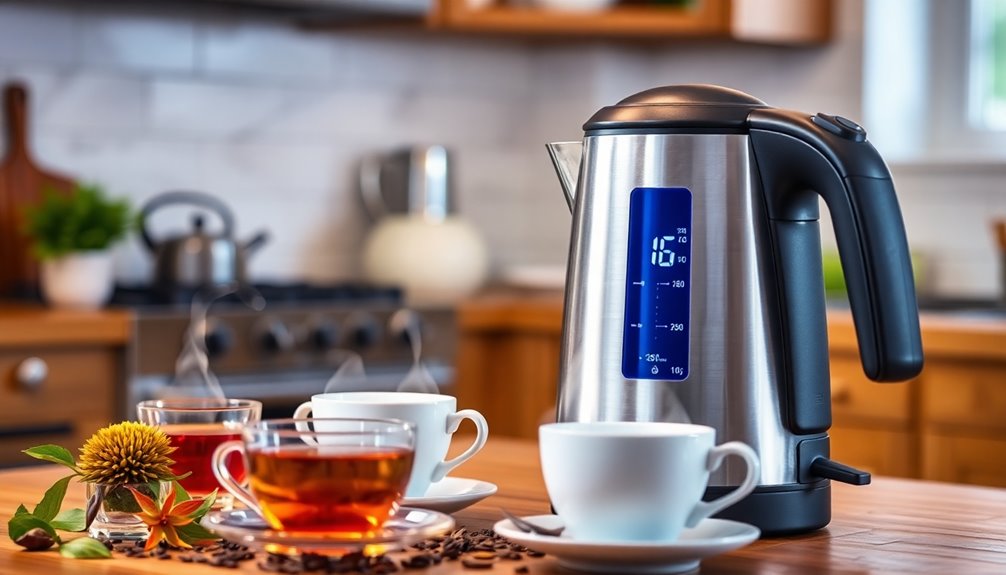
Understanding the optimal brewing temperatures for different types of tea can take your tea experience to the next level. When you have temperature control kettles, you can brew each tea to perfection.
For instance, green tea needs a gentle touch, requiring water between 65°C and 80°C. If it's too hot, your tea can taste bitter and unpleasant.
Black tea, on the other hand, loves the heat! It brews best between 93°C and 100°C, unlocking its rich flavors.
Oolong tea finds its sweet spot in the middle, enjoying water at about 85°C to 96°C. This range helps bring out its complex tastes without overpowering them.
Lastly, herbal infusions thrive with boiling water at 100°C. This temperature fully extracts the beneficial compounds and delightful flavors from the herbs.
Using kettles with precision temperature control means you can easily hit these optimal brewing temperatures. You'll not only enhance the taste of your tea but also enjoy the health benefits that come from brewing it just right.
Smart Kettles With App Control

Imagine brewing your perfect cup of tea without even stepping into the kitchen! With smart kettles featuring app control, you can adjust temperature settings right from your smartphone. This means you can enjoy precise brewing for different tea types, whether you're lounging on the couch or busy with chores.
Many smart kettles come with customizable presets for specific teas, so you can easily select optimal temperatures and steeping times with just a few taps. This takes the guesswork out of brewing.
Plus, you'll get notifications on your phone when the water reaches the desired temperature or when the kettle is done boiling, making it super convenient.
Some advanced models even offer real-time temperature monitoring and historical data, helping you refine your brewing techniques for the best flavor. They can also integrate with your smart home system, allowing for voice activation and automation with other kitchen appliances.
User Misunderstandings of Temperature Settings
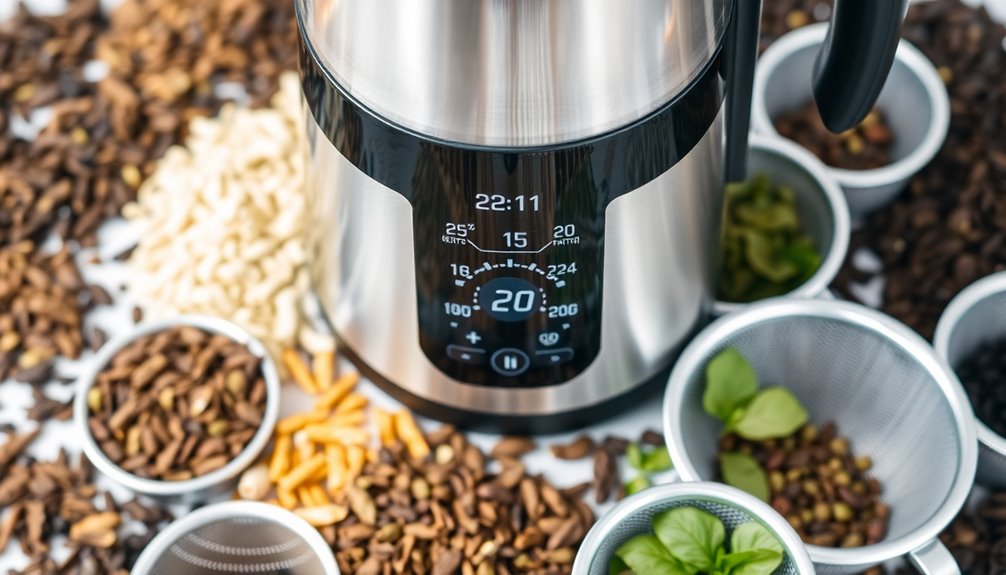
Misconceptions about temperature settings can lead to disappointing tea experiences. Many people think that all kettles are the same, but temperature-controlled kettles give you precise temperature options, usually from 140°F to boiling. This is important because different teas need specific temperatures to taste their best.
For example, delicate teas like green tea can turn bitter if brewed at temperatures above 176°F (80°C).
Another common misunderstanding is the belief that higher brewing temperatures always create better flavor. In reality, teas like oolong and herbal infusions shine at particular temperatures, bringing out their unique flavors and aromas.
Also, don't forget to preheat your teapot or cups! Skipping this step can lead to inconsistent brewing temperatures, affecting your tea's quality.
Lastly, while some people think all electric kettles are energy-efficient, those with precise temperature controls can save energy. They heat water only to the necessary temperature for each brew, making them a valuable addition to your kitchen.
Practical Applications
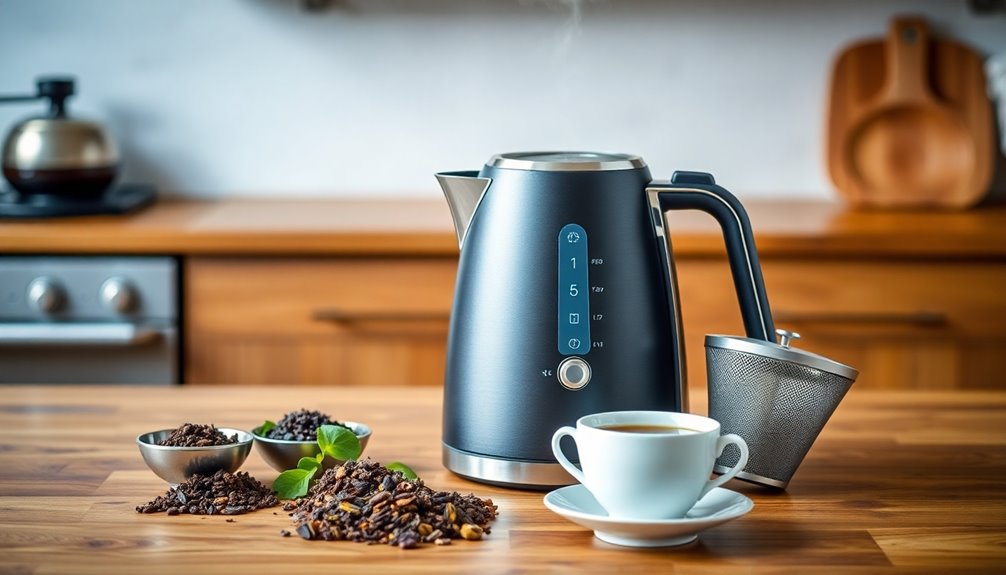
With the right temperature control kettle, you can elevate your tea brewing experience significantly. These kettles let you select specific temperatures, usually ranging from 140°F to boiling. This ensures that you hit the ideal temperature ranges for different types of tea, like green teas, which need lower temperatures for the best flavor extraction.
Many modern kettles come with a handy hold function that keeps your water at the selected temperature for a while, so you can brew multiple cups without worrying about over-extraction.
Plus, if you choose a kettle with a gooseneck spout, you'll enjoy precise pouring control, allowing you to use various brewing techniques effectively.
Temperature control kettles also quickly reach desired temperatures, saving you time when you're busy. With enhanced temperature accuracy, you'll achieve a perfect cup of tea every time, exploring different tea varieties and their unique flavor profiles.
Whether you're brewing a delicate green tea or a robust black tea, these kettles make sure that you get the most out of your leaves, transforming each cup into a delightful experience.
Frequently Asked Questions
What Are the Benefits of Temperature Control Kettle?
You'll enjoy precise brewing with a temperature control kettle, enhancing flavor and aroma. It heats quickly, maintains consistent temperatures, and saves energy, making your tea experience more enjoyable and efficient for your busy lifestyle.
Is Temperature Control Important for Tea?
Yes, temperature control's crucial for tea. You'll unlock the best flavors and avoid bitterness by brewing at the right temperatures. Experimenting with different teas becomes easier, enhancing your overall experience and enjoyment of each cup.
Do You Need a Temperature-Controlled Kettle?
You don't necessarily need a temperature-controlled kettle, but it makes achieving the perfect brew much easier. You'll enjoy your tea more when it's brewed at the right temperature, enhancing its flavor and aroma significantly.
Is a Variable Temperature Kettle Worth It?
A variable temperature kettle's definitely worth it! You'll enjoy precise control over your brewing temperatures, enhancing flavor and consistency. Plus, you can brew different teas without constantly reheating, making your tea experience much more enjoyable.
Conclusion
In conclusion, temperature control kettles really can change how you enjoy tea. By brewing at the right temperature, you unlock delicious flavors and aromas. Plus, with smart kettles, you can easily set the perfect heat from your phone! Remember, understanding the right temperatures makes a big difference. So, whether you're making green tea or black tea, using a precise kettle will help you brew the best cup every time. Happy tea brewing!

